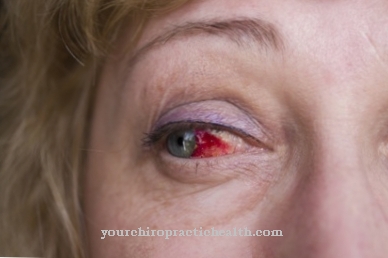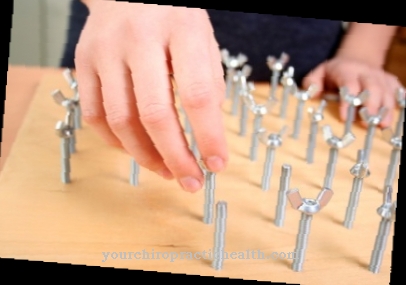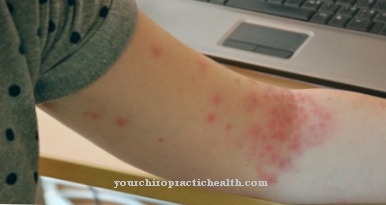Twitching in the leg arise from involuntary muscle contractions. Although mostly harmless, the muscle twitching can seriously affect the quality of life in the long run.
What are leg twitches?

Muscle twitches can occur in almost any muscle part of the body, but extremities, especially the legs, are particularly common. Muscle twitching is a colloquial expression for sudden involuntary movements of the muscles of individual muscle groups.
Muscle twitching can also occur anywhere in the facial muscles. Leg twitches can occur once and temporarily or chronically; those affected then feel the twitches daily for a period of at least 3 months. The intensity of the twitching in the leg varies from patient to patient. The causes are mostly harmless in nature, but prolonged twitching always creates a certain level of suffering.
In particular, if the muscles have been twitching for a long time, a medical examination is necessary, because the muscle twitching as a symptom can also hide serious clinical pictures of the nervous system, which can only be ruled out with the help of extended diagnostics. Medical contacts for leg twitches are general practitioners, neurologists, psychiatrists and orthopedists.
causes
Leg twitches can have different intensities and degrees of severity, if the muscle twitching is clearly visible, the doctor speaks of myoclonus, as it can occur, for example, in an epileptic seizure. There is also a risk of injury.
As a rule, less muscle movements occur due to more harmless causes, which can be perceived as fine skin tremors; the doctor then speaks of fasciculations. The leg twitches can be arrhythmic or rhythmic in character and occur once or regularly, depending on the cause. Regularly repetitive muscle contractions in the leg are also known as tremors. Fasciculations on the leg arise in small muscle bundles, if a muscle twitch can be arbitrarily increased, then a so-called action myoclonus is present.
External stimuli such as noises, light or touch can also lead to twitching. The symptom of muscle twitching is associated with many neurological disorders, including Parkinson's disease, multiple sclerosis, or epilepsy. Febrile convulsions with infections, diabetes mellitus or orthopedic symptoms with nerve irritation can also cause the twitching in the leg.
Last but not least, the involuntary muscle contractions can also be an expression of a psychosomatic ailment. The most common neurological disease that causes leg twitching is restless legs syndrome, which occurs particularly during sleep.
Diseases with this symptom
- Magnesium deficiency
- Restless legs syndrome
- Diabetes mellitus
- Myopathy
- Circulatory disorders
- multiple sclerosis
- Polyneuropathy
- epilepsy
- Parkinson's
Diagnosis & course
Talking to the doctor is very important for the diagnosis and prognosis of the course of the disease. Because with a targeted questioning about localization, intensity or triggering factors, the doctor can in most cases very quickly find the underlying cause.
If it turns out that a patient is acutely affected by a mental imbalance such as lovesickness or grief, then the involuntary muscle contractions in the leg are a somatic expression of a psychodynamic event. If the doctor finds out during the conversation that his patient is consuming alcohol or drugs, then the cause of the leg twitches is quickly found in this case too.
This is followed by physical and neurological examinations with electroencephalography, electroneurography and, if necessary, electromyography; during this examination, the electrical activity, for example in the thigh muscle, can be measured in real time. Depending on the findings, an extended diagnosis in the form of muscle biopsies, magnetic resonance or CT examinations or CSF punctures can follow, for example to confirm the suspected diagnosis of multiple sclerosis.
Complications
As a rule, twitching in the leg is not a worrying condition. However, there may be various complications that require medical treatment. In addition, the complications also depend on the underlying disease that is responsible for the twitching in the leg.
Irregular twitching is quite normal when you are overloaded. However, complications can still arise, such as constant numbness. In such a case, there is a risk that individual nerves have been permanently damaged. However, this can be remedied through explicit therapy. If the twitches were caused by an external force, it can under certain circumstances lead to enormous restrictions in individual movements.
If the twitching is triggered by an existing arthritis, it can also lead to severe inflammation of the joints. The aforementioned inflammations are accompanied by severe pain that persists even when the patient is resting. In rare cases, the twitches are triggered by a vitamin deficiency, which can lead to a general malaise. At the same time, the immune system is weakened and extremely vulnerable, so that there is a risk of infection with a virus.
When should you go to the doctor?
Leg twitching can result from many different causes, but they do not always need to be treated by a doctor directly. Often times, twitching in the leg is caused by unusual strain, which can cause the leg to shake. However, this appearance should completely disappear on its own after a few hours. If this is not the case, a visit to the doctor should be considered.
Under certain circumstances, there is an underlying disease that requires treatment by an appropriate doctor. It is not uncommon for there to be an explicit nutritional deficiency, which, however, can be quickly remedied by taking the missing substance. In addition, a circulatory disorder can also be responsible for twitching in the leg. Anyone who suffers from regular leg twitches should therefore seek medical treatment early enough. The chances of a quick and complete recovery are only possible if treatment is given in good time.
However, anyone who completely refrains from medical treatment in the event of permanent twitching in the leg is at great risk. There is a risk of serious complications that can even lead to permanent consequential damage.
The following applies: If twitching occurs on the leg once, a doctor is definitely not necessary. An examination by an appropriate doctor should only take place if the leg twitches regularly.
Doctors & therapists in your area
Treatment & Therapy
If the cause of the leg twitching has been established, any possible treatment should be based on it. Therapy for leg twitches is based on the three pillars of relaxation, medication and surgery. The doctor will recommend relaxation procedures particularly in those cases in which the muscle contractions often disappear on their own and no physical-pathological findings could be made.
Avoiding stress and changing and adapting living conditions are always advisable in the case of psychosomatic muscle twitching. Progressive muscle relaxation, yoga and autogenic training have proven particularly helpful. If there are manifest illnesses causing the twitches, different groups of drugs are used, for example neuroleptics, antidepressants or anticonvulsants, which chemically interrupt the contraction cycle in the muscles.
All of these drugs require a prescription and some of them have significant side effects. To monitor therapy and progress, it is necessary at regular intervals to check the blood level of the medication and, if necessary, adjust the dose until there are no symptoms. For epileptics who suffer from permanent twitching in the leg, a surgical intervention on the triggering brain region may be indicated in order to permanently relieve the stressful tremor.
Outlook & forecast
Twitching in the leg can be triggered for many different reasons, so that an exact prognosis and prospect of the course of the disease is very difficult. In most cases, twitching in the leg occurs very rarely and goes away completely on its own. In other cases the twitches in the leg occur permanently or at very short intervals one after the other.
Repeated twitching of the leg can be a sign of severe iron deficiency. Anyone who refrains from medical treatment or appropriate medication in such a case must reckon with a considerable worsening of the symptoms that occur. However, if the person concerned consults a doctor early on, the iron deficiency can be eliminated with appropriate preparations. If the twitches in the leg were triggered by this, they should no longer occur in the future.
In other cases, twitching in the leg can also occur due to excessive strain on the muscles. In such a case, a visit to the doctor is not necessary. The prospect of a full recovery and healing is possible without any problems even without medical treatment. The affected person should protect the affected area and keep it quiet. A significant improvement should occur after just one or two days.
prevention
In most cases, leg twitches are harmless, of a temporary nature and an expression of mental overload and stress. Avoiding stress factors and learning relaxation methods can therefore be prevented. If painful cramps also occur, emphasis should be placed on a balanced diet with a high magnesium content.
If you are susceptible and disposed, the consumption of alcohol, nicotine or drugs must be avoided. Direct prevention against nerve disorders such as amyotrophic lateral sclerosis, multiple sclerosis or Parkinson's to avoid muscle twitching is not possible.
You can do that yourself
Leg twitches can have a number of causes and should therefore always be discussed with your doctor. Often the symptoms can be alleviated by simple home remedies and measures. The symptoms may be due to a magnesium deficiency, which can be compensated for by a balanced diet and appropriate dietary supplements. Dietary measures such as avoiding caffeine and alcohol help relax the muscles and thus reduce the twitching in the long term.
The twitches may also be triggered by a drug. If this is the case, the attending physician must prescribe an alternative preparation. In addition, psychotherapeutic measures such as autogenic training or meditation can reduce twitching in the leg. Other general measures include light exercise and improving sleep hygiene. In addition, everyday stress should be reduced if possible.
If you suspect polio, degeneration of the cervical spine or serious muscle diseases, you should refrain from taking any measures yourself. The affected limbs must be spared until medical treatment. In the event of unusual twitching in the context of a diagnosed nerve disease, the medication may have to be changed. Sometimes relaxation techniques such as yoga or physiotherapy can also alleviate the symptoms.

















.jpg)







.jpg)


